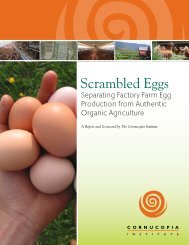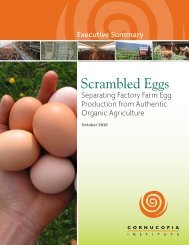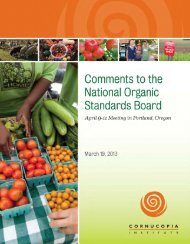“Behind the Bean” (pdf) - Cornucopia Institute
“Behind the Bean” (pdf) - Cornucopia Institute
“Behind the Bean” (pdf) - Cornucopia Institute
You also want an ePaper? Increase the reach of your titles
YUMPU automatically turns print PDFs into web optimized ePapers that Google loves.
more grazing land.<br />
While it is unlikely that certified organic soybeans are grown directly on recently cleared rain forest land, 49 conventional<br />
soybeans used in soy foods such as nutrition bars and vegetarian burgers may well have been grown on former rain forest<br />
land. Solae, which is a major supplier of conventional soy protein ingredients for nutrition bars and vegetarian bars, is an<br />
alliance between Du Pont and Bunge Limited. 50 Bunge, an agribusiness corporation based in New York but formerly based<br />
in Brazil, 51 owns Bunge Brasil. In 2005, Bunge bought soybeans from 30,000 growers in Brazil. 52<br />
According to <strong>the</strong> Rainforest Action Network, “Bunge is <strong>the</strong> largest exporter of soy from Brazil, where <strong>the</strong> crop has become<br />
<strong>the</strong> greatest driver of deforestation in <strong>the</strong> Amazon and <strong>the</strong> Cerrado.” The Rainforest Action Network also reports that<br />
Bunge continues to buy soy from plantations that have been blacklisted by <strong>the</strong> Brazilian government for using slave labor.<br />
Conventional soybeans used<br />
in soy foods such as nutrition<br />
bars and vegetarian burgers<br />
may well have been grown on<br />
former rain forest land.<br />
Nonprofit groups like Greenpeace and <strong>the</strong> Rainforest Action Network<br />
are working hard toward <strong>the</strong> goal of ensuring that no soybeans are planted<br />
on former rain forest land. In 2006, Greenpeace pressured major users<br />
of Brazilian soybeans to stop buying <strong>the</strong>m, such as McDonald’s in Europe,<br />
which fed <strong>the</strong> soybeans to chickens destined for McNuggets. And<br />
in July 2006, companies that are heavily involved in soybean production<br />
agreed to a two-year moratorium, stopping <strong>the</strong> trade of soybeans grown<br />
on newly deforested land. The moratorium was extended one more year<br />
and is now in effect until July 23, 2009. 53<br />
Some believe that <strong>the</strong> moratorium is working; o<strong>the</strong>rs, including Friends of <strong>the</strong> Earth and Conservation International, contest<br />
this assertion. They note that Brazil’s environment ministry recently said that as much as 7,000 square kilometers of<br />
Brazil’s rain forest was cleared from August through December, reversing a three-year decline in <strong>the</strong> pace of deforestation. 54<br />
While it may not always be soy, “<strong>the</strong>re’s a clear link between agriculture and deforestation, with livestock and <strong>the</strong>n grain<br />
farmers such as corn playing a significant role in deforestation,” said Paulo Gustavo do Prado Pereira, environmental policies<br />
director at Conservation International. 55<br />
O<strong>the</strong>rs, including Greenpeace, believe that <strong>the</strong> moratorium is working because <strong>the</strong>se acres were not cleared specifically for<br />
soybean production. The first field survey since <strong>the</strong> moratorium, in March 2008, found no soybeans were grown in any of<br />
<strong>the</strong> 193 deforested areas within <strong>the</strong> three states of Mato Grosso (<strong>the</strong> number one soy-producing state), Para, and Rondonia.<br />
Greenpeace noted that “<strong>the</strong> moratorium is doing its job and halting soya related forest destruction, despite <strong>the</strong> pressure<br />
from rising soya prices.” However, Greenpeace’s Amazon campaign director, Paulo Adario, said he is still concerned because<br />
much of <strong>the</strong> deforestation has occurred in areas next to existing soybean plantations, suggesting that <strong>the</strong> grain fields could<br />
move into those areas to meet growing international demand. 56<br />
Today, Bunge continues to buy Brazilian soybeans, and <strong>the</strong>re does not appear to be any guarantee that <strong>the</strong>se Brazilian soybeans<br />
do not end up in “natural” nutrition bars, vegetarian burgers, and o<strong>the</strong>r soy foods. Since Solae, a major supplier of soy<br />
protein isolate to “natural” food companies, is a subsidiary of Bunge, it is possible that “natural” products and “green” foods<br />
containing soy protein are made with Brazilian soybeans.<br />
3.<br />
22 Behind <strong>the</strong> bean: The Heroes and Charlatans of <strong>the</strong> Natural and Organic Soy Foods Industry.





